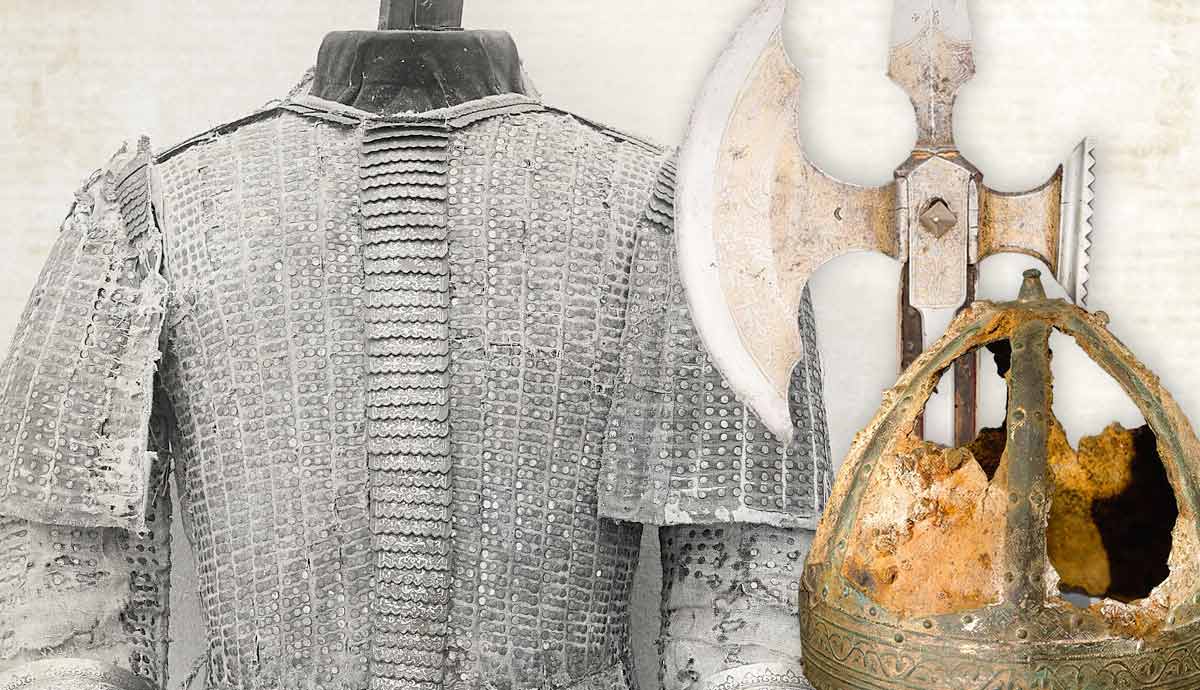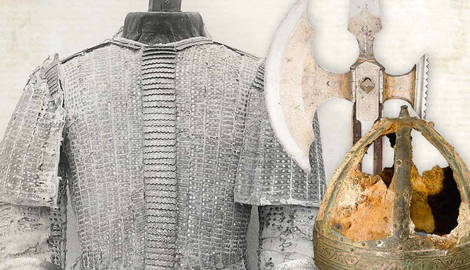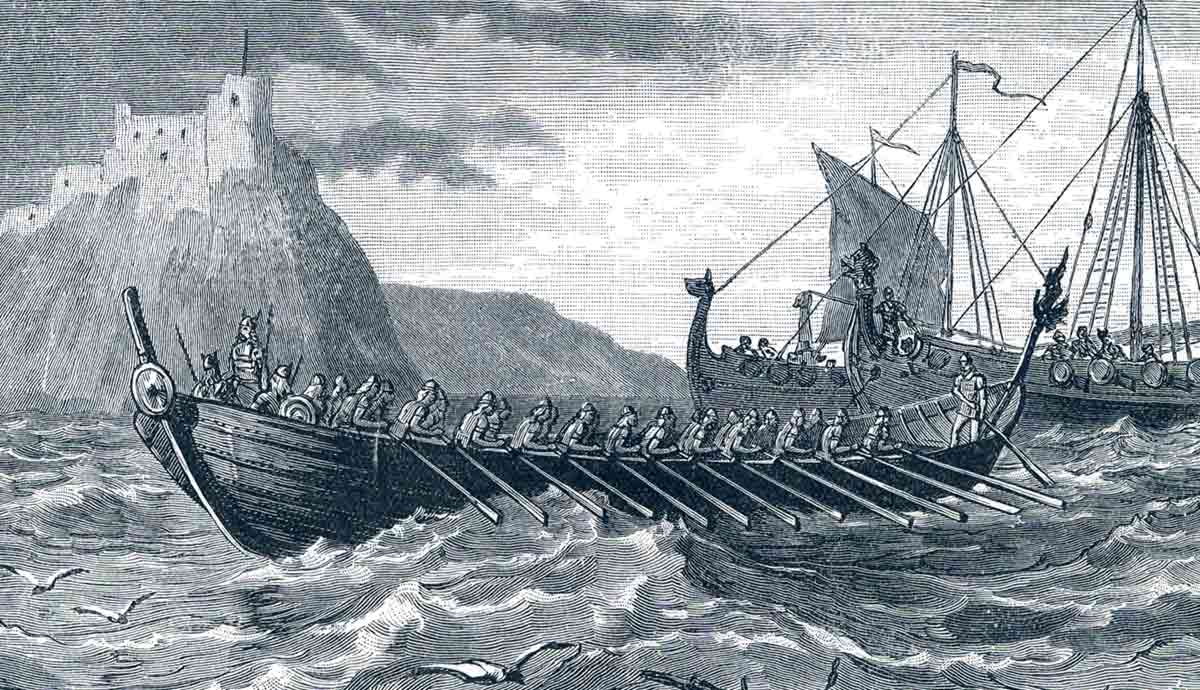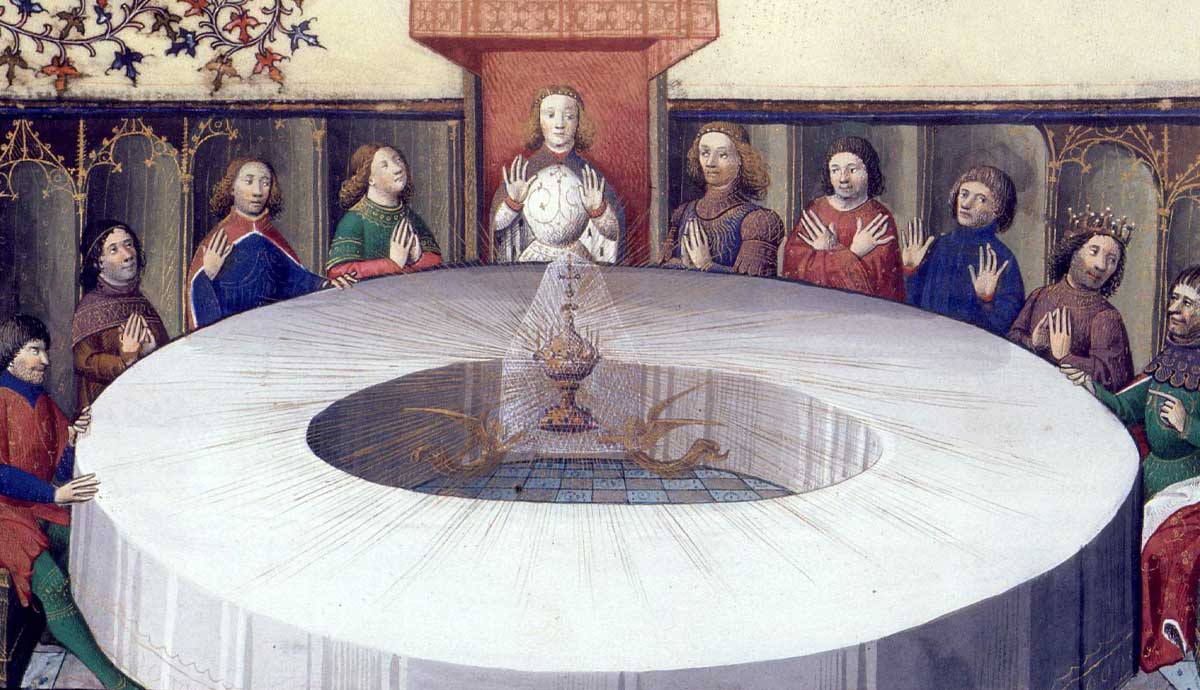
The Medieval Period, which roughly stretched from 500 to 1500 CE, was a turbulent time of near-constant conflict. In order to gain an edge on the battlefield, armorers and weapons makers developed an astonishing variety of weapons to deal out damage and armor to keep a warrior alive. While far from a comprehensive list, this is a collection of some of the most interesting weapons and armor found on a medieval battlefield.
1. Helmets & Head Protection

The single most important body part is the head, and therefore the number one priority of a soldier was to acquire a helmet of some kind. In late antiquity and the early medieval period, one of the more common types of helmet has been dubbed the Spangenhelm. It was made from a number of metal plates held together by a framework of metal strips. This was much easier to produce than a helmet made from a single piece of metal. The spangenhelm had a roughly conical shape with no sharp edges. This meant that strikes would be more likely to glance off of the helmet rather than take the full force of the impact. This helmet type would advance further, becoming more conical in shape and have the addition of a nasal guard to protect the face while still giving the wearer unobstructed visibility. These more advanced conical helms were used well into the 11th century and beyond, with iconography depicting them used by the Normans during the conquest of England in 1066.
For more complete protection, other options included the Great Helm, which was cylindrical in shape and completely covered the head. Visibility was provided by slits that were too narrow to stab or shoot through, as well as breathing holes to allow for some ventilation. The flat top of the helmet meant that the full force of the impact of a blow from above would be imparted on the helmet. But this type of helmet was primarily used by cavalry, so strikes from above were rare. By the late 13th or early 14th century, this evolved into the Sugarloaf Helm, which had a dome or conical top, which was more efficient at deflecting blows.

As technology advanced, helmets began to be equipped with visors, which meant that the user could choose between visibility and ventilation with a raised visor, or protection by lowering it. One of these helms was called the Basinet, which usually had a pointed visor that was hinged on the brow of the helmet.
Other helmets used during the medieval period were the Sleek Sallet, the Greek-inspired Barbute, and the wide brimmed Kettle Helm, which would later inspire the Brodie Helmet that was used by the British military in the First and Second World Wars. There were also more specialized helmets such as the Frog Faced Helm, which was completely enclosed, with visibility possible only through a slit at the top of the helmet and was generally used for jousting. There are countless variants of each of these helmet types and many more types of head protection that were used during the Middle Ages.
2. Medieval Armor & Mail

With the head protected, the next priority was to protect the rest of the body. The most common and easiest to produce was a garment called a Gambeson. This was a padded cloth jacket that could vary in length from about the waist to past the knee. If thick enough, a Gambeson could protect the wearer from slashes and cuts, lessen the impact of blunt force trauma, and though it could be vulnerable to punctures, was still much more effective than it may seem. Even if a warrior had more advanced metal armor, a Gambeson, or something similar, such as an arming doublet, would be worn underneath to act as padding and to prevent the metal from pinching into flesh. It was worn throughout the Middle Ages by both upper and lower classes. Cloth caps could also be worn as standalone protection or under helmets to absorb the force of impacts.
For more substantial armor, the most common was mail. Sometimes called chain mail by mistake, mail was made from interlocking metal rings that, when combined with the padded undercoat, provided a significant amount of protection. It was made into a garment called a Hauberk, which could range in size from roughly t-shirt dimensions to full arm length sleeves and a length that reached down past the knees. A mail hood called a Coif could be worn over the head under the helmet, providing even more head protection. As metallurgy advanced, a new type of armor was created called the Coat of Plates, since that is exactly what it is. It was made from individual steel plates riveted or sewn together with a fabric frame. This would evolve into the Brigandine, which was made from smaller plates of metal, and would be popular in the later portions of the Middle Ages and even into the early modern era.

The peak of armor came with the development of full plate armor. Made from large sheets of steel, as time went on the armor became more advanced, featuring articulated joints that allowed full range of motion and was so encompassing that there were hardly any vulnerable openings. The steel would be hardened and all but impenetrable, even by powerful bows, crossbows, and even early firearms. While this may have made the wearer, usually a knight or nobleman, all but invulnerable, there were some downsides. The first of which was the expense. These were hand crafted by master artisans, and were often custom made for the wearer. Because of this, a full suit of high quality plate was monumentally expensive. The other issue was putting on and taking off the armor. The separate pieces had to be attached and strapped into place properly, which more often than not required the help of another person.

In the late Middle Ages, regional variations of armor were developed. Two major centers of armor production were Milan and northern Italy, which created the sleek Milanese plate—which was often asymmetrical, offering more protection on the more vulnerable left side of the body—and Germany, which created Gothic plate. This type can be identified by the prominent grooves that gave the armor additional strength without adding weight.
3. Medieval Shields

Armor wasn’t the only way for a warrior to defend himself. Many types of shields found their way onto medieval battlefields and could be used both offensively and defensively. They were primarily made out of wood and covered in canvas or leather, usually rawhide. It would also be rimmed with rawhide or metal. Many versions also had a boss, a domed piece of metal that protected the hand if it was gripped in the center. As armor became more advanced, shields became less and less common, but were still used even into the early modern era.
Shields in the early Medieval period were usually round and gripped in the center, a design that gave way to the Kite Shield, an elongated teardrop shield that was initially used by cavalry. This became smaller over time, evolving into the Heater Shield, which was flat topped with a roughly triangular shape. Both Heater and Kite shields would be strapped to the arm rather than held by a center grip. At the end of the Middle Ages, the Pavise, a type of Tower Shield, was used primarily by crossbowmen and handgunners as a form of mobile cover when reloading their weapons. There were also Bucklers, small disks of metal about the size of a dinner plate that could be easily carried, but lacked significant protection due to their size.

The primary role of a shield would be to block enemy attacks, absorbing the impact directly, or by using the rim to knock an attack to the side. Though defensive in nature, shields could also be used offensively, the rim or boss slammed into an opponent to knock them off balance, or thrust into the face to obscure vision, setting up a strike with the primary weapon.
4. Spears and the Pole Axe

By far the most common type of weapon used in the Middle Ages were Polearms of some kind, which are any number of weapons attached to the end of a long wooden shaft. The most common type was the humble spear, which was about six to eight feet in length. Cheap and simple to produce, they were the primary weapon of both the lower classes, who could form packed ranks of infantry to repel the enemy, and mounted knights. As armor evolved, however, this simple weapon was not enough. Once knights were fully ensconced inside of full plate armor, a spear tip would simply bounce off. Something more substantial was needed.

The Poleaxe is a multi-purpose polearm used by knights that combines the best aspects of several different weapons in a single package. There are several different versions of the poleaxe, but one of the most common configurations is a spear, hammer, and an axe in a single weapon. Foremost, it is a spear, which has a longer range than a sword or mace and allows the user to thrust at vulnerable areas of an opponent. Some versions have a spike instead of a spearhead, which is thinner and able to get into the gaps in plate armor, but has a smaller wound channel. The hammer provides blunt force trauma, able to simply bash an armored opponent into submission. The long, two-handed shaft was able to generate a tremendous amount of force. The axe head can chop into unarmored enemies with ease, but would likely glance off of any substantial armor. It was still useful, however. The shape of the axe could be used to hook onto an opponent’s neck or shoulder and drag him to the ground, or pull a leg out from underneath him. The shaft could also be used like a quarterstaff, knocking the enemy’s weapon offline, used to sweep the legs, or pushing the opponent back with the butt of the weapon and setting up a more powerful stroke.
Because of the extra weight at the end of the weapon, it was usually much shorter than a conventional spear, about the height of the wielder, or maybe a few inches longer. Poleaxes were usually used by the upper classes, so any disadvantage in reach would be offset by the higher level of armor worn by someone of the higher social order. They were usually used on foot in both the battlefield and in duels.
5. The Arming Sword

If there is one weapon that is emblematic of the Middle Ages, it would be the sword. At first, swords were expensive and a sign of wealth and status. This changed over the course of the Middle Ages and swords became more and more commonplace as time went on, something that was helped by a widespread used arms and armor market that made weaponry more accessible to the masses. Even at their most popular, however, they were rarely the primary weapon of a soldier, but used either as a backup on the battlefield or as a self defense weapon in a civilian context.
The most common type of sword was the Arming Sword, which was derived from the Roman Spatha. It was a single-handed, double-edged, and straight-bladed weapon that had a cruciform hand guard. The blades came in all manner of shapes and sizes, which was the result of sword makers constantly experimenting with designs to improve performance. Although some arming swords were better suited for one task or another, they were multi-purpose weapons that could cut with the edge or stab with the tip, and even bludgeon with the pommel.
Arming Swords were fairly lightweight, weighing between one and three pounds on average. They were secondary weapons, used as a backup if the primary weapon broke or was lost. Since the primary weapon was often a lance used from horseback, it would often shatter on impact or become stuck in the unfortunate victim. When this happened, the Arming Sword would be drawn and used either from horseback or on foot. It was rarely used alone and would almost always be paired with a heater shield. The Arming Sword would increase in length, and by the late Middle Ages would evolve into the hand and a half sword and the two-handed longsword.
6. The Warhammer

While iconic, swords can have difficulty penetrating armor, and so more specialized weapons would be employed. One of the more popular anti-armor weapons was the Warhammer. Unlike popular perceptions, these were much smaller and lighter than often depicted in popular culture. Rather than the Mjolnir sized sledgehammers wielded by fantasy heroes, these were more compact, with the head of one-handed versions roughly the size of a modern claw hammer. The hammer head was given ridges or prongs to add friction so it wouldn’t slide off of smooth armor. The Warhammer would often be made with a curved spike on the opposite end, which added an armor piercing capability to the weapon. The downside to this is the risk of the spike getting stuck in the target after impact. There are also two-handed versions of the weapon, though the line between a Warhammer, a Poleaxe, and other weapons is a bit of a gray area.
Warhammers had the majority of their weight located towards the head of the weapon, which increases the force on impact. While it is much more nimble than many assume, the concentration of weight makes it harder to swing than a sword of the same weight. This means a one-handed warhammer was typically shorter than a sword, the user sacrificing reach for impact.
7. Hand Cannons

The medieval era saw the introduction of possibly the most significant development in military history: gunpowder. First invented in China in the 9th century, ironically while alchemists were looking for the elixir of eternal life, its military applications were soon apparent. Gunpowder reached Europe in the 13th century, and with it, warfare changed forever.
Initially used as artillery, warriors wasted little time turning cannons into personal weapons. The Hand Cannon is exactly what it sounds like. It is a simple metal tube that was mounted on the end of a wooden shaft. There would be a touch hole at the base of the tube that was filled with gunpowder. When touched by a flame, the powder in the barrel would ignite, firing a stone bullet towards the target. This was an era before rifling, and the user tucked the wooden handle under his arm or braced it on the ground before firing, which made aiming difficult. As a result, these were inaccurate, and were more of a psychological weapon, the loud bang and puff of smoke unnerving to men and horses alike. They were also dangerous. Faulty forging processes or an excessive powder charge could cause the Hand Cannon to explode.










